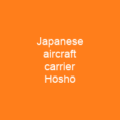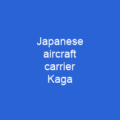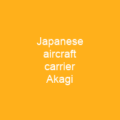Hōshō: The Pioneering Aircraft Carrier of the Imperial Japanese Navy
Imagine a time when aircraft carriers were still in their infancy, and the world was just beginning to grasp the immense potential they held. That’s where Hōshō comes into play – the world’s first commissioned aircraft carrier built by the Imperial Japanese Navy in 1922. How did this small but mighty ship shape naval warfare?
The Birth of an Innovator
Hōshō was initially designed as a seaplane carrier, but its journey to becoming the world’s first commissioned aircraft carrier was far from straightforward. The ship underwent numerous revisions based on British designs, including the addition of a rear flight deck and an unobstructed full-length flight deck. These changes were like adding wings to a bird – they transformed Hōshō into something truly revolutionary.
Design and Specifications
Hōshō was no ordinary ship. With an overall length of 168.25 meters, a beam of 17.98 meters, and a mean draft of 6.17 meters, it was designed to carry 32 aircraft but ended up with a smaller airgroup due to its small size. The ship’s propulsion system, consisting of two Parsons geared turbine sets with 30,000 shaft horsepower and eight Kampon Type B water-tube boilers, allowed Hōshō to reach speeds up to 30 knots – fast enough to keep pace with the fleet.
Operational Highlights
Hōshō’s first major test came during the Shanghai Incident and Sino-Japanese War. Supporting Imperial Japanese Army ground operations, Hōshō engaged in aerial combat, proving its worth as a versatile platform. The ship’s air group initially consisted of 9 Mitsubishi 1MF fighters and 3-6 torpedo bombers but was later replaced with A1N1 (Type 3) aircraft.
Shanghai Incident and Beyond
In 1932, Hōshō participated in the Shanghai Incident, engaging Chinese fighters. In 1935, she was damaged during Combined Fleet Maneuvers but managed to return to service after extensive repairs. By 1939, her aircraft elevators were enlarged, and she began operating A4N1 (Type 95) fighters and B4Y1 (Type 96) torpedo bombers.
World War II and Beyond
Hōshō’s role expanded during World War II. Assigned to the Third Carrier Division, she provided air support for the Combined Fleet’s ‘Main Body’ battle-line of six battleships. However, her small size limited her potential value in future conflicts.
Midway and Beyond
Hōshō’s involvement in the Battle of Midway was brief but significant. She provided air protection, scouting, and anti-submarine support before being relegated to training duties. By 1945, Hōshō had seen better days, with her flight deck damaged during an air raid. Despite emergency repairs, she was eventually scrapped in Osaka from September 2, 1946, to May 1, 1947.
Repatriation and Final Days
After the war, Hōshō served as a repatriation transport, carrying about 40,000 passengers back to Japan from various locations. Her final days were spent moored and camouflaged off Nishinomishima at Kure before being transferred to the Home Ministry for disposal.

Hōshō’s legacy lies in its pioneering role and the lessons it taught. From its initial design as a seaplane carrier to becoming an aircraft carrier, Hōshō was a testament to innovation and adaptability. As we look back on her journey, one thing is clear: the future of naval warfare was born with this small but mighty ship.
Hōshō’s story serves as a reminder that even in the face of adversity, creativity and determination can lead to groundbreaking achievements. From its humble beginnings to its final days, Hōshō remains an iconic symbol of the evolution of naval aviation.
You want to know more about Japanese aircraft carrier Hōshō?
This page is based on the article Japanese aircraft carrier Hōshō published in Wikipedia (retrieved on March 11, 2025) and was automatically summarized using artificial intelligence.







